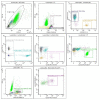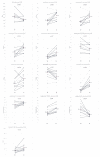Analysis of Leukocyte Subpopulations by Flow Cytometry during Hospitalization Depending on the Severity of COVID-19 Course
- PMID: 37893102
- PMCID: PMC10604221
- DOI: 10.3390/biomedicines11102728
Analysis of Leukocyte Subpopulations by Flow Cytometry during Hospitalization Depending on the Severity of COVID-19 Course
Abstract
The mechanisms underlying the immune response to coronavirus disease 2019 (COVID-19) and the recovery process have not been fully elucidated. The aim of the study was to analyze leukocyte subpopulations in patients at significant time points (at diagnosis, and 3 and 6 months after infection) selected according to the analysis of changes in the lungs by the CT classification system, considering the severity of the disease. The study groups consisted of severe and non-severe COVID-19 patients. There was a significant decrease in CD8+ T cells, NK and eosinophils, with an increasing percentage of neutrophils during hospitalization. We noticed lower levels of CD4 and CD8 T lymphocytes, eosinophils, basophils, and CD16+ monocytes and elevated neutrophil levels in severe patients relative to non-severe patients. Three months after infection, we observed higher levels of basophils, and after 6 months, higher CD4/CD8 ratios and T cell levels in the severe compared to non-severe group. Non-severe patients showed significant changes in the leukocyte populations studied at time of hospitalization and both within 3 months and 6 months of onset. The CT CSS classification with parameters of the flow cytometry method used for COVID-19 patients determined changes that proved useful in the initial evaluation of patients.
Keywords: B lymphocytes; SARS-CoV-2 infection; T lymphocytes; flow cytometry; leukocytes; lymphocytes; neutrophils.
Conflict of interest statement
The authors declare no conflict of interest.
Figures




Similar articles
-
Cytokines and Leukocytes Subpopulations Profile in SARS-CoV-2 Patients Depending on the CT Score Severity.Viruses. 2021 May 11;13(5):880. doi: 10.3390/v13050880. Viruses. 2021. PMID: 34064802 Free PMC article.
-
Poor Survival in COVID-19 Associated with Lymphopenia and Higher Neutrophile-Lymphocyte Ratio.Isr Med Assoc J. 2021 Mar;23(3):153-159. Isr Med Assoc J. 2021. PMID: 33734627
-
Lymphocyte Subset Alteration and Monocyte CD4 Expression Reduction in Patients with Severe COVID-19.Viral Immunol. 2021 Jun;34(5):342-351. doi: 10.1089/vim.2020.0166. Epub 2020 Nov 23. Viral Immunol. 2021. PMID: 33264073
-
A systematic meta-analysis of immune signatures in patients with COVID-19.Rev Med Virol. 2021 Jul;31(4):e2195. doi: 10.1002/rmv.2195. Epub 2020 Nov 20. Rev Med Virol. 2021. PMID: 34260780 Free PMC article.
-
[Deep lung--cellular reaction to HIV].Rev Port Pneumol. 2007 Mar-Apr;13(2):175-212. Rev Port Pneumol. 2007. PMID: 17492233 Review. Portuguese.
Cited by
-
High Serum S100A12 as a Diagnostic and Prognostic Biomarker for Severity, Multidrug-Resistant Bacteria Superinfection and Herpes Simplex Virus Reactivation in COVID-19.Viruses. 2024 Jul 5;16(7):1084. doi: 10.3390/v16071084. Viruses. 2024. PMID: 39066246 Free PMC article.
-
The Association of Blood Eosinophils and Neutrophils Expressing Eosinophilic Surface Markers with the Severity and Outcome of COVID-19.Microorganisms. 2024 Dec 4;12(12):2503. doi: 10.3390/microorganisms12122503. Microorganisms. 2024. PMID: 39770705 Free PMC article.
References
-
- Rutkowska E., Kwiecien I., Zabicka M., Maliborski A., Raniszewska A., Klos K., Urbanska W., Klajnowicz I., Rzepecki P., Chcialowski A. Cytokines and Leukocytes Subpopulations Profile in SARS-CoV-2 Patients Depending on the CT Score Severity. Viruses. 2021;13:880. doi: 10.3390/v13050880. - DOI - PMC - PubMed
Grants and funding
LinkOut - more resources
Full Text Sources
Research Materials
Miscellaneous

